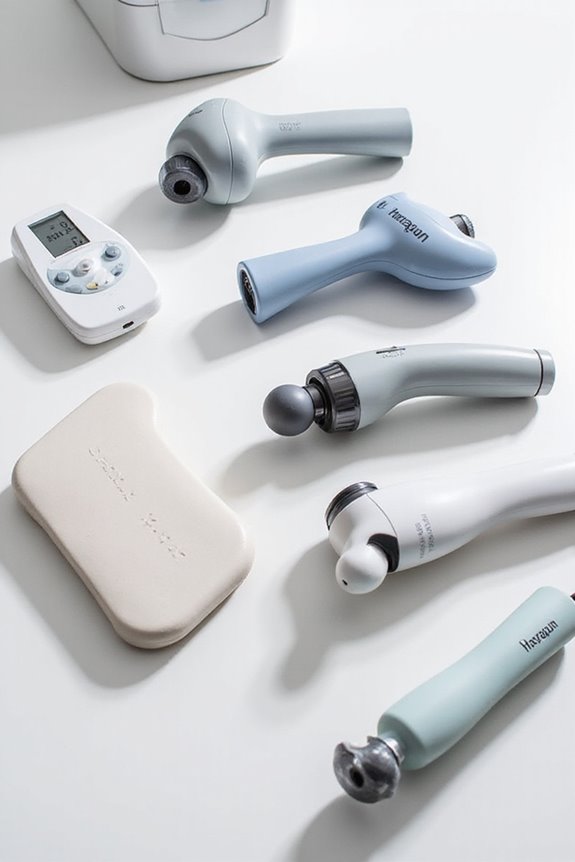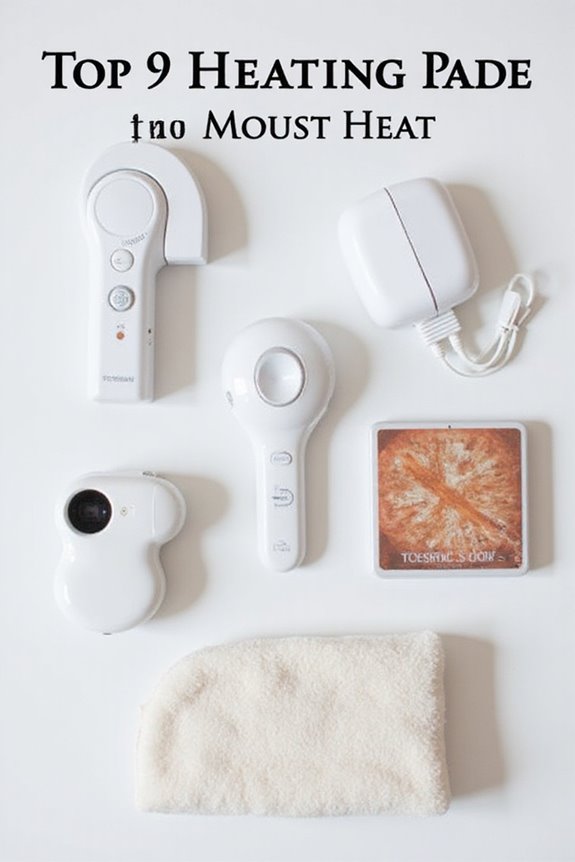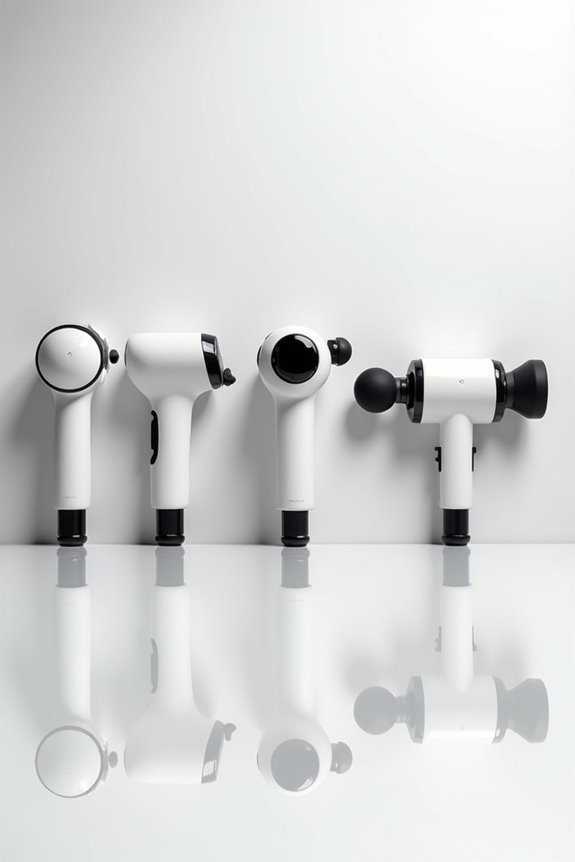As an Amazon Associate, we earn from qualifying purchases. Some links may be affiliate links at no extra cost to you. Although our opinions are based on curated research, we haven't used these products. Articles generated with AI.
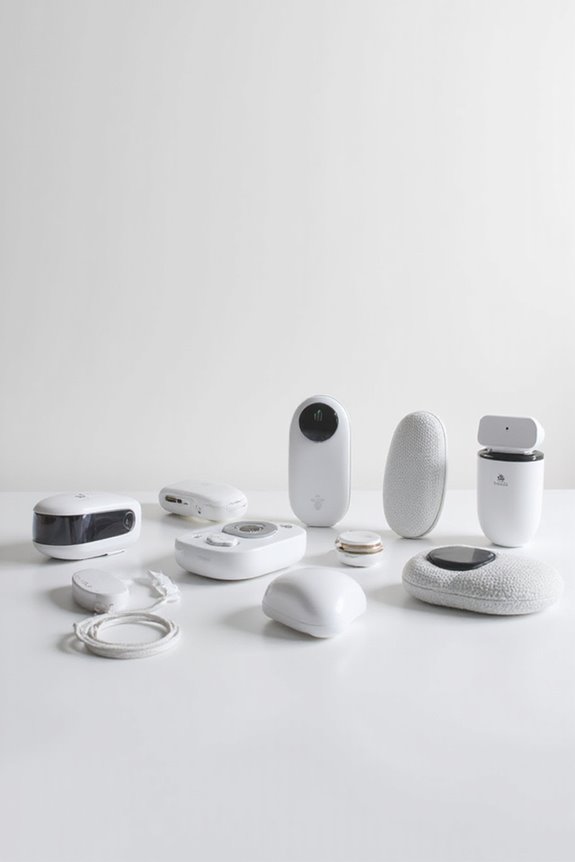
The 9 Best Transcranial Direct Current Stimulation Devices You Need to Know About Today
If you’re exploring transcranial direct current stimulation (tDCS) devices, there are some standout options to evaluate. The BrainDriver v2 offers customizable currents from 0.5mA to 2.0mA and includes 8 sponge sets for convenience. Another excellent choice is the NeuroMyst Pro, which combines tACS and tDCS functionalities. Key factors, like portability and electrode placement, matter too. Interested in which devices make the best impact? Let’s take a closer look at the top options you shouldn’t miss.
Key Takeaways
- TheBrainDriver v2 offers portable, user-friendly tDCS with selectable current outputs and safety timers, ideal for home use.
- NeuroMyst Pro combines tACS and tDCS, providing customizable settings for intensity and frequency to enhance brain stimulation.
- TENS Unit Muscle Stimulator provides drug-free pain management with multiple modes and intensity levels for individualized treatment.
- Professional-grade tDCS devices typically cost under $100, making them an affordable alternative to traditional therapies.
- Effective tDCS devices enhance mood and cognitive function, with personalized protocols improving treatment engagement and outcomes.
TENS Unit Muscle Stimulator for Pain Relief and Therapy
TENS Unit Muscle Stimulator, Electronic PMS Pulse Massager Machine for Shock Physical Therapy, Back...
- TRUE INDEPENDENT TENS UNIT: Choose between 24 modes and 20 intensity levels on each channel individually, for a wider range of muscle stimulation, pain relief, and body...
- USB-C PORT FOR FAST 40 MIN FULL CHARGE: PMS muscle stimulator, up to 20 hours of continuous use per charge. Easy to read LCD backlit screen with enlarged icons for a...
- DRUG FREE PAIN RELIEF: Safe TENS therapy delivers back sciatica nerve pain relief among other common ailments like neck pain, carpal tunnel, arthritis, shoulder, knee,...
If you’re dealing with chronic pain or looking for a way to speed up muscle recovery after workouts, the TENS Unit Muscle Stimulator might be your best ally. This portable device uses electronic pulses for drug-free pain relief, tackling issues like sciatica, neck pain, and arthritis. With 24 modes and 20 intensity levels, it tailors treatment to your specific needs.
Key features include:
- USB-C charging for a fast, 40-minute full charge.
- Up to 20 hours of continuous use.
- Easy-to-read LCD screen.
With this portable kit, you can achieve personal pain relief at home without the hassle of medication or costly doctor visits.
Best For: Individuals suffering from chronic pain conditions or those seeking efficient muscle recovery after workouts.
Pros:
- Versatile functionality with 24 modes and 20 intensity levels to customize pain relief.
- Portable and convenient, allowing for easy use at home or on-the-go with a protective case.
- Long battery life, providing up to 20 hours of continuous use after a quick 40-minute charge.
Cons:
- Initial investment may be higher compared to traditional pain relief methods.
- Requires proper placement of electrode pads for effective results, which may be challenging for some users.
- Limited to electrical stimulation therapy, which may not be suitable for all types of pain or preferences.
tDCS Journal & Montage Placement Guide
tDCS Journal & Montage Placement Guide: Transcranial Direct Current Stimulation
- Zimmerhoff, Tobias R. (Author)
- English (Publication Language)
- 162 Pages - 03/15/2017 (Publication Date) - CreateSpace Independent Publishing Platform (Publisher)
The tDCS Journal & Montage Placement Guide is ideal for both beginners and experienced users of transcranial direct current stimulation (tDCS) devices looking to enhance their stimulation sessions. This affordable resource, priced around $10, combines easy-to-follow electrode placement illustrations with a journaling feature.
Best For: Users of transcranial direct current stimulation (tDCS) devices seeking a practical and affordable resource for electrode placement and session documentation.
Pros:
- Consolidates multiple montages in one location for easy reference.
- Clear illustrations enhance understanding of electrode placement, boosting user confidence.
- Priced affordably at around $10, making it a cost-effective alternative to more expensive resources.
Cons:
- Lacks detailed information on recommended amperage and session duration.
- Some content may be repetitive or sourced from online material, diminishing its value.
- A significant portion of the journal consists of blank pages, limiting useful content.
TheBrainDriver v2 tDCS Device with 8 Sets of Sponges
No products found.
For those seeking a reliable transcranial direct current stimulation (tDCS) device, the BrainDriver v2 tDCS Device stands out as an exceptional choice. This complete, ready-to-use system is designed for professional use and comes with 8 sets of sponges, ensuring you have everything needed right away.
Key features include:
- Selectable current outputs: 0.5mA, 1.0mA, 1.5mA, 2.0mA
- 20 & 30-minute safety timers with auto shut-off
- Pocket-sized, perfect for travel
With its digital precision and built-in safety features, you’ll feel confident using this device to enhance your tDCS experience. Why settle for anything less?
Best For: Individuals seeking a professional-grade, portable tDCS device for home use or travel.
Pros:
- Fully equipped with 8 sets of sponges for immediate use.
- Multiple current output options to tailor the stimulation level.
- Compact design makes it convenient and easy to carry.
Cons:
- May require some knowledge of tDCS to use effectively.
- Limited to the preset current levels, which may not suit all users.
- Initial investment may be higher compared to basic tDCS devices.
TENS Unit Muscle Stimulator for Pain Relief
Sale
TENS Unit Muscle Stimulator, EMS Massager Machine for Shoulder, Neck, Sciatica and Back Pain Relief,...
- ALL IN ONE KIT: Includes TENS EMS massager electronic device, 16 reusable electrode replacement pads in Small, Medium and Large sizes, 2 dual plug snap cables, USB...
- TENS Muscle Massager with multiple functions for back pain relief and muscle stimulation. It can be used for all muscle soreness and trouble areas like neck, back, abs,...
- SCIATICA PAIN RELIEF AT HOME: Back massager electronic device for body pains like lower back, sciatica or sore muscles. Small portable device with easy to use functions...
Struggling with muscle pain caused by daily activities or sports injuries? The TENS Unit Muscle Stimulator might be what you need. This all-in-one kit includes:
- A TENS EMS device
- 16 reusable electrode pads in various sizes
- Dual plug snap cables
- A USB charging cable, pad holders, an instruction manual, and a travel case.
With 24 modes and 20 intensity levels, you can easily find what works for you. Users often report significant relief from pain in the neck, back, and shoulders. Plus, its compact design makes it perfect for everyday use, helping with muscle recovery and soreness.
Best For: Individuals seeking effective pain relief and muscle stimulation for conditions like neck tension, back pain, or sports-related injuries.
Pros:
- Provides significant relief mimicking deep tissue massage, especially for neck and shoulder tensions.
- Compact and portable design, ideal for daily use and easy to carry for travel.
- Offers a variety of modes and intensity levels, catering to different user preferences and pain management needs.
Cons:
- Mode navigation can be cumbersome as users must cycle through all modes sequentially.
- Some users report issues with adhesive pads losing their effectiveness after limited uses.
- Device longevity varies, with some experiencing functionality issues after several months of use.
TENS Unit Muscle Stimulator for Pain Relief
Sale
TENS Unit Muscle Stimulator, EMS Massager Machine for Shoulder, Neck, Sciatica and Back Pain Relief,...
- ALL IN ONE KIT: Includes TENS EMS massager electronic device, 16 reusable electrode replacement pads in Small, Medium and Large sizes, 2 dual plug snap cables, USB...
- TENS Muscle Massager with multiple functions for back pain relief and muscle stimulation. It can be used for all muscle soreness and trouble areas like neck, back, abs,...
- SCIATICA PAIN RELIEF AT HOME: Back massager electronic device for body pains like lower back, sciatica or sore muscles. Small portable device with easy to use functions...
Finding a reliable solution for pain relief can be a challenge, especially if you deal with chronic issues in your shoulders, neck, or back. The TENS Unit Muscle Stimulator is a great option worth considering. Here’s what you’ll find in the kit:
- TENS EMS device
- 16 reusable electrode pads (various sizes)
- Dual plug snap cables and USB charging cable
- Travel case
With 24 modes and 20 intensity levels, this compact device effectively targets muscle soreness and offers sciatica relief. Users report noticeable pain reduction, resembling deep tissue massage, making it perfect for post-workout relaxation.
Best For: Individuals seeking effective pain relief for muscle soreness, particularly in the neck, shoulders, and back.
Pros:
- Effective pain relief that mimics deep tissue massage, particularly beneficial for post-workout recovery.
- Compact and portable design allows for easy use anywhere, with a rechargeable battery lasting up to a month.
- Responsive customer support that assists with inquiries and offers hassle-free refunds.
Cons:
- Cumbersome mode navigation as users must cycle through all modes sequentially, which can be inconvenient.
- Pad adhesion issues occur after limited uses, leading to the need for additional medical tape or replacement pads.
- Variable device longevity, with some users experiencing functionality issues after only a few months of use.
NeuroMyst Pro tDCS Device Kit
No products found.
The NeuroMyst Pro tDCS Device Kit stands out as an ideal choice for individuals looking to enhance their brain stimulation experience with advanced technology. Featuring both tACS and tDCS, it’s lightweight and portable, perfect for daily use. You can easily customize settings like intensity (0.1-4 mA), time (1-60 min), and frequency (0.2-80Hz) to tailor your experience.
Key benefits include:
- Professional-grade overload protection and safety features
- Clear digital meter for connection quality
- Complete kit including USB charger, electrodes, sponges, and a hard case
Best For: Individuals seeking a customizable and advanced brain stimulation experience for personal wellness and cognitive enhancement.
Pros:
- Professional-grade safety features ensure safe usage, minimizing risks associated with electrical stimulation.
- Lightweight and portable design makes it easy to use and carry for daily use.
- Customizable settings allow for tailored brain stimulation experiences with adjustable intensity, time, and frequency.
Cons:
- Individual health effects may vary, meaning results are not guaranteed for everyone.
- Requires a certain level of knowledge or understanding of tDCS technology for optimal use.
- It’s a personal device, so support and guidance might be limited for new users.
Transcranial Direct Current Stimulation in Neuropsychiatric Disorders
Transcranial Direct Current Stimulation in Neuropsychiatric Disorders: Clinical Principles and...
- Amazon Kindle Edition
- English (Publication Language)
- 1034 Pages - 09/12/2016 (Publication Date) - Springer (Publisher)
Transcranial Direct Current Stimulation (tDCS) devices stand out as an innovative treatment option for individuals experiencing neuropsychiatric disorders, particularly when traditional therapies haven’t yielded desired results. These devices work by applying a mild electrical current to the scalp, which can stimulate brain activity. You might wonder how that relates to common conditions like depression or anxiety.
Key benefits include:
- Enhanced neuroplasticity, helping your brain adapt.
- Potential improvements in mood and cognition.
With ongoing research, tDCS is becoming a valued tool for neurologists and psychiatrists seeking effective solutions for treatment-resistant cases. Ready to explore this cutting-edge therapy?
Best For: Individuals experiencing treatment-resistant neuropsychiatric disorders, particularly those with depression and anxiety.
Pros:
- Enhanced neuroplasticity, allowing the brain to adapt and reorganize itself.
- Non-invasive procedure with minimal side effects compared to traditional therapies.
- Promising clinical outcomes for mood and cognitive improvements in patients.
Cons:
- Limited long-term efficacy data available, necessitating ongoing research for validation.
- Variability in individual responses, which may lead to inconsistent results across different patients.
- Requires professional administration, potentially limiting accessibility for some individuals.
TENS Unit Muscle Stimulator Pro for Pain Relief and Recovery
TENS Unit Muscle Stimulator Pro for Back Pain Relief, Shoulder Recovery and Physical Therapy,...
- Versatile Pain Relief: Experience drug-free pain relief with safe TENS therapy for back pain, neck pain, carpal tunnel, shoulder, knee, elbow, leg, and foot pain. The...
- All-in-One Kit: This comprehensive kit includes a TENS EMS Pro massager electronic device with 36 modes and 20 intensity levels on each channel individually. It comes...
- Portable & Convenient: This true independent TENS unit offers portable, fast, and easy muscle relaxation through electrical pulses, allowing you to use it anywhere you...
For those seeking drug-free pain relief and recovery, the TENS Unit Muscle Stimulator Pro is a standout choice. This portable device targets a variety of pain, from back to shoulder discomfort. Here’s what you’ll love:
- Versatile Modes: With 36 modes and 20 intensity levels per channel, you can customize your treatment.
- User-Friendly Design: The easy-to-read LCD screen and included instruction manual help you get started quickly.
- Long Battery Life: A quick two-hour charge powers up to 50 hours of use.
Consider consulting a Physiotherapist for the best pad placement, and enjoy effective relief right at home!
Best For: Individuals seeking effective, drug-free relief from chronic pain conditions like sciatica, shoulder pain, or those who prefer at-home recovery options.
Pros:
- Versatile: Offers 36 modes and 20 intensity levels per channel for personalized treatment.
- Portable: Compact design and included travel case make it easy to use anywhere.
- Long-lasting Battery: Fast USB-C charging provides up to 50 hours of use on a single charge.
Cons:
- Manual Adjustments Needed: Users may have to adjust intensity each session, which can be inconvenient.
- Pad Stickiness Issues: Electrode pads may lose stickiness over time, requiring replacements.
- Potential Need for Professional Guidance: Consulting a therapist for optimal pad placement may be necessary for best results.
TheBrainDriver v2 tDCS Device
No products found.
When you’re seeking a portable and user-friendly option for enhancing focus and mood, the tDCS Device TheBrainDriver v2 stands out as an excellent choice. With a pocket-sized design, it weighs only 12 ounces and measures 5 x 1 x 2.5 inches, making it easy to travel with. Users appreciate its features, including four current levels (up to 2.0mA) and a safety timer with automatic shut-off. Many report improvements in mood and reduced anxiety within two weeks. Just remember, proper electrode care with saline is essential, so keep some handy. Explore the benefits of this affordable device for mental clarity today!
Best For: Individuals looking for a portable and effective solution to enhance focus, mood, and manage symptoms of anxiety and depression.
Pros:
- Easy to use with straightforward controls
- Multiple features including timer and power levels
- Effective for mood enhancement and mental clarity
Cons:
- Requires 9V battery (non-rechargeable)
- Device size may be cumbersome for some users
- Needs saline for operation, which may not always be convenient
Factors to Consider When Choosing Transcranial Direct Current Stimulation
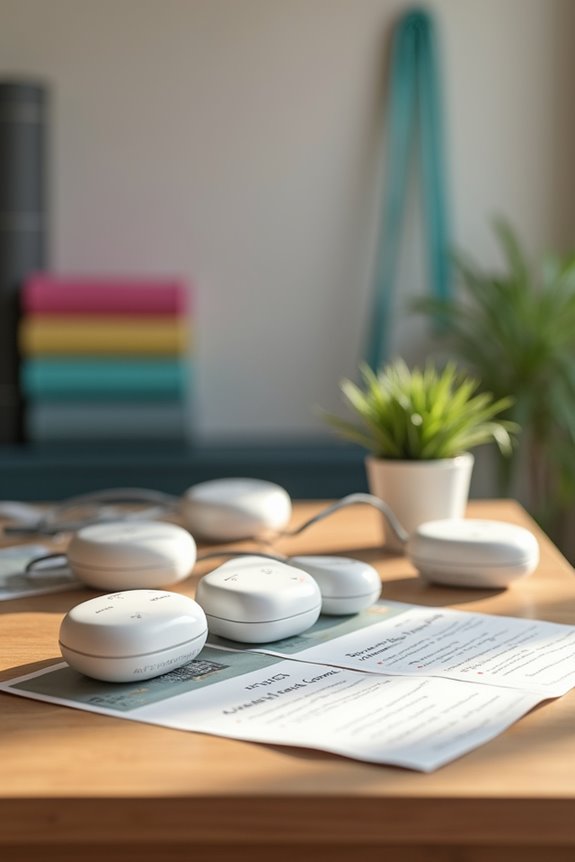
When you’re looking into transcranial direct current stimulation (tDCS) devices, there are several key factors to keep in mind. You’ll want to think about the portability and design of the device, as well as the current output options it offers. Safety features, electrode placement techniques, and customization options can greatly enhance your experience, so it’s worth considering each of these elements carefully.
Device Portability and Design
Choosing the right transcranial direct current stimulation (tDCS) device often hinges on portability and design, key factors that can greatly influence your experience. You’ll want a lightweight, compact device that’s easy to transport for use anywhere. Look for pocket-sized options that allow you to have stimulation sessions during travel or daily routines.
Consider these features:
- Secure electrode fit: Guarantees reliable stimulation during use.
- User-friendly interface: Makes operating the device simpler.
- Rechargeable battery: Provides convenience and flexibility away from power sources.
- Robust construction: Assures durability during transport.
With the right design, you can enjoy your tDCS experience without hassle, making it more accessible and enjoyable in diverse settings.
Current Output Options
Selecting the ideal current output for your transcranial direct current stimulation (tDCS) device is essential, as it directly affects how effective and comfortable your sessions will be. tDCS devices typically offer current outputs ranging from 0.5mA to 2.0mA. Here are a few factors to evaluate:
- Intensity: Higher currents may enhance stimulation effects, but they can also cause discomfort or irritation.
- Customization: Look for devices that allow precise adjustments, helping you tailor the output to your comfort and treatment goals.
- Start Low: It’s recommended to begin with lower currents and gradually increase them as you assess your tolerance.
Finding the right balance will help you maximize both effectiveness and comfort during your tDCS sessions.
Safety Features Importance
While exploring your options in transcranial direct current stimulation (tDCS) devices, it’s crucial to prioritize safety features that protect you during your sessions and enhance your experience. Here are key aspects to reflect on:
- Automatic Shut-Off: This feature prevents prolonged stimulation, reducing chances of skin irritation.
- Overload Protection: Safeguards current output stays within safe limits to prevent adverse effects.
- Digital Meter: Helps check connection quality, making certain electrodes are placed correctly and function properly.
- Preset Timers: Allow you to choose session durations, optimizing benefits while minimizing overuse risks.
- Safety Certifications: Look for devices with clear health compliance guidelines.
Focusing on these safety features can greatly improve your tDCS usage and promote a more effective and enjoyable experience.
Electrode Placement Techniques
Understanding how to place electrodes correctly is a key factor in maximizing the benefits of transcranial direct current stimulation (tDCS). Proper electrode placement influences the targeted brain area and treatment efficacy. Here are some common montage configurations:
- FPz to Cz targets cognitive functions.
- F3 to F4 focuses on emotional regulation.
To enhance accuracy, use clear guides and illustrations that show anatomical landmarks. Improve conductivity and adhesion with saline-soaked sponges or conductive gel, essential for effective stimulation. Additionally, keep a journal to document electrode placements; tracking different montages can help you refine your technique based on personal efficacy. This way, you can optimize your tDCS experience and achieve better results.
Customization and Flexibility
When diving into transcranial direct current stimulation (tDCS), you’ll quickly notice the importance of customization and flexibility in your treatment sessions. Here’s what to take into account:
- Current Intensity: You can select levels from 0.1 to 4 mA, tailoring it to your comfort and therapy goals.
- Session Duration: Most devices let you set times from 1 to 60 minutes, catering to your personal schedule.
- Frequency Settings: Range from 0.2 Hz to 80 Hz, allowing targeted stimulation for specific neurological conditions.
- Personalized Protocols: Some devices allow you to create and store your treatment plans, enhancing engagement over multiple sessions.
- Electrode Placement: Flexibility in this area lets you target various brain regions, improving your overall treatment effectiveness.
Affordability and Value
Affordability is a crucial factor to evaluate when choosing a transcranial direct current stimulation (tDCS) device, especially as you explore different treatment options. Many tDCS devices are priced considerably lower than traditional therapies, making them accessible. Consider these points:
- Professional-grade devices often cost under $100, while advanced models can exceed this.
- Some tDCS kits come with additional accessories like electrodes and sponges, adding value without extra costs.
- Compared to other therapies for neuropsychiatric conditions, tDCS offers a cost-effective solution with ongoing benefits.
Effective tDCS devices can boost your mood and cognitive function, making them worthwhile investments for anyone seeking non-invasive treatments at reasonable prices. So, which tDCS device will you choose?
Frequently Asked Questions
Are Tdcs Devices Safe for Home Use?
Using a transcranial direct current stimulation (tDCS) device at home can feel like bringing a bit of science into your routine. Generally, tDCS devices are safe, but safety depends on following instructions carefully and choosing reputable products. Always check for:
- Certification marks
- User reviews
- Clear guidelines
Consulting with a healthcare professional before use is wise, especially if you have health concerns. So, do your homework, stay informed, and be safe!
How Long Should a Tdcs Session Last?
For a transcranial direct current stimulation (tDCS) session, you should aim for about 20 to 30 minutes. This duration is typically effective for enhancing brain stimulation without causing discomfort. Remember, consistency is key! Here are a few tips:
- Start with shorter sessions, then gradually increase.
- Make sure you’re in a calm environment.
- Keep track of your progress over time.
Can Tdcs Help With Memory Enhancement?
When it comes to enhancing memory, you might want to give transcranial direct current stimulation (tDCS) a shot. While results can vary, research suggests it can boost working memory. Here’s what you should know:
- tDCS can increase neuron activity temporarily.
- Sessions usually last 20-30 minutes.
- It’s non-invasive and affordable.
Just keep in mind, more studies are needed, and it’s wise to consult with a professional before hopping on board.
What Are the Side Effects of Tdcs Devices?
When using transcranial direct current stimulation (tDCS) devices, you might experience side effects like mild skin irritation, headaches, or dizziness. While most people tolerate tDCS well, it’s important to be aware of these possibilities. Other potential effects could include tingling sensations or, in rare cases, temporary mood changes. Always consult with a healthcare professional before starting any tDCS treatment, especially if you have existing medical conditions or concerns. Stay informed!
Do I Need a Prescription for Tdcs Devices?
You usually don’t need a prescription for TDCS devices, as many are available for personal use. However, it’s wise to consult a healthcare professional before starting, especially if you have underlying health issues. Here’s why:
- You want to guarantee it’s right for your needs.
- A professional can guide proper usage.
- They can provide insights into potential side effects.
Always prioritize your safety and well-being when considering any new treatment!







